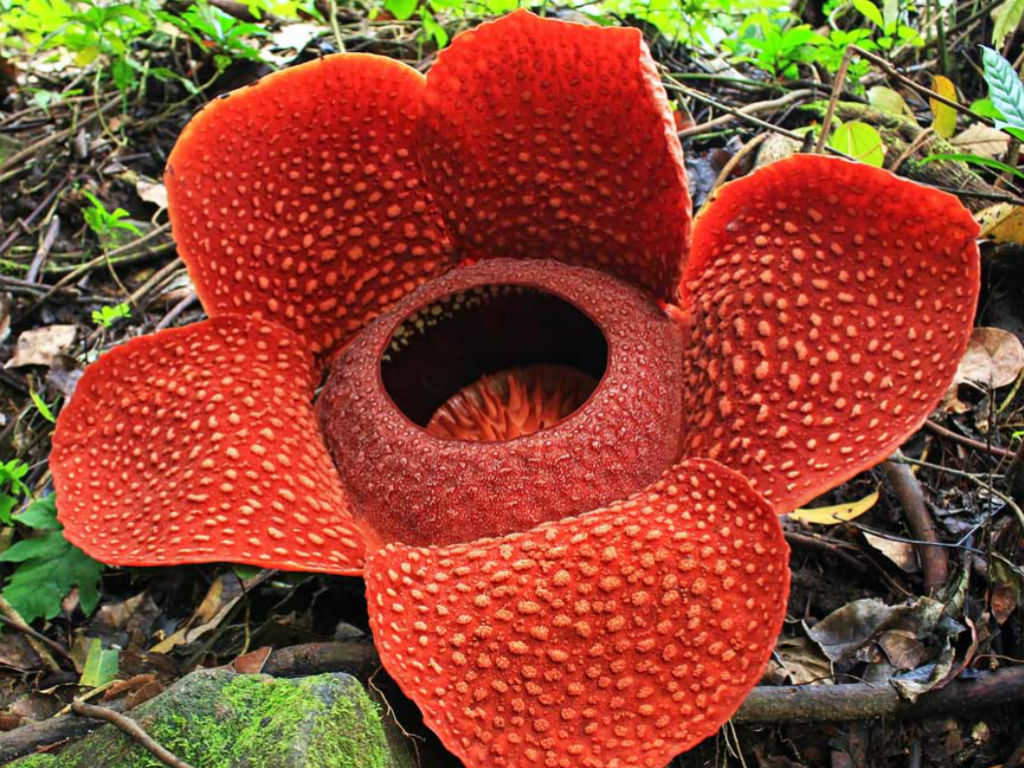Flora & Fauna
Rafflesia arnoldii
Rafflesia arnoldii is a species of flowering plant in the parasitic genus Rafflesia. It is noted for producing the largest individual flower on earth. It has a very strong and horrible odour of decaying flesh, earning it the nickname "corpse flower". It is endemic to the rainforests of Sumatra and possibly Borneo. Although there are some plants with larger flowering organs like the titan arum (Amorphophallus titanum) and talipot palm (Corypha umbraculifera), those are technically clusters of many flowers.
Rafflesia arnoldii (Indonesian: padma raksasa), also called Kerubut (Devil's Betelnut Box) is one of the three national flowers in Indonesia, the other two being the white jasmine and moon orchid. It was officially recognized as a national "rare flower" (Indonesian: puspa langka) in Presidential Decree No. 4 in 1993.
Rafflesia arnoldii is rare and fairly hard to locate. It is especially difficult to locate the flower in forests, as the buds take many months to develop and the flower lasts for just a few days. The flowers are unisexual and thus proximity of male and female flowers is vital for successful pollination. These factors make successful pollination a rare event.
When Rafflesia is ready to reproduce, a tiny bud forms outside the root or stem of its host and develops over a period of a year. The cabbage-like head that develops eventually opens to reveal the flower. The stigma or stamen are attached to a spiked disk inside the flower. A foul smell of rotting meat attracts flies and beetles to pollinate. To pollinate successfully, the flies and/or beetles must visit both the male and female plants, in that order. The fruit produced are round lots filled with smooth flesh including many thousands of hard-coated seeds that are eaten and spread by treeshrews.
Classification:
Kingdom : Plantae
Clade :
Angiosperms
Clade :
Eudicots
Clade :
Rosids
Order :
Malpighiales
Family :
Rafflesiaceae
Genus :
Rafflesia
Species :
R. arnoldii
Life Cycle
Reproduction
The Rafflesia’s life cycle begins when the parasitic growths
on the plant’s vine root form small buds that resemble cabbage.
Bud Growth
Rafflesia lacks leaves, stems and chlorophyll, and is incapable
of photosynthesis. Instead, the buds grow by living off of the plant’s vine,
draining nutrients and water from it.
Flowers
In about nine months, the bud bursts, revealing an enormous,
five-petaled flower. The reddish-brown flowers give off a pungent odor similar
to rotting flesh, which attracts insects for pollination. Rafflesia plants are
unisexual and most often produce either male or female flowers at a single site. To succed at polinating the plant, insects must visit both male and female flowers, which are usually not in close proximity to one another.
Fruit
The fruit has smooth flesh that contains numerous tiny seeds. Once fruit and flower have both reached maturity, which takes five to seven days, this marks the end of plant's life cycle.
Seeds
The smell of the fruit's dead flesh attracts indigenous animals. The animals distribute the seeds, continuing the plant's life cycle.
Facts
References
Fruit
The fruit has smooth flesh that contains numerous tiny seeds. Once fruit and flower have both reached maturity, which takes five to seven days, this marks the end of plant's life cycle.
Seeds
The smell of the fruit's dead flesh attracts indigenous animals. The animals distribute the seeds, continuing the plant's life cycle.
Facts
- Rafflesia is the largest individual flower. Titan arum bears the largest inflorescence.
- The genus Rafflesia is named after adventurer and founder of the British colony of Singapore, Sir Stamford Raffles.
- Rafflesia arnoldii does not have chlorophyll, as all the green plants have and so it cannot undergo photosynthesis.
References
http://wwf.panda.org/about_our_earth/teacher_resources/best_place_species/current_top_10/rafflesia.cfm
https://en.wikipedia.org/wiki/Rafflesia_arnoldii
Q&A
1. Can we found this in Indonesia?
Of course we can in Borneo.
2. Is this dangerous for us?
No it isn't but if you dont like stink then use the mask.
3. Where we can found this?
5. How the rafflesia can produce the flowers?
In about nine months, the bud bursts, revealing an enormous, five-petaled flower. The reddish-brown flowers give off a pungent odor similar to rotting flesh, which attracts insects for pollination. Rafflesia plants are unisexual and most often produce either male or female flowers at a single site. To succed at polinating the plant, insects must visit both male and female flowers, which are usually not in close proximity to one another.Q&A
1. Can we found this in Indonesia?
Of course we can in Borneo.
2. Is this dangerous for us?
No it isn't but if you dont like stink then use the mask.
3. Where we can found this?
These spectacular plants are found only in peninsular Malaysia, Sumatra, Java, southern Thailand, Borneo and southern Philippines. All known species of Rafflesia are threatened or endangered.
4. What is this?
5. How the rafflesia can produce the flowers?

Comments
Post a Comment